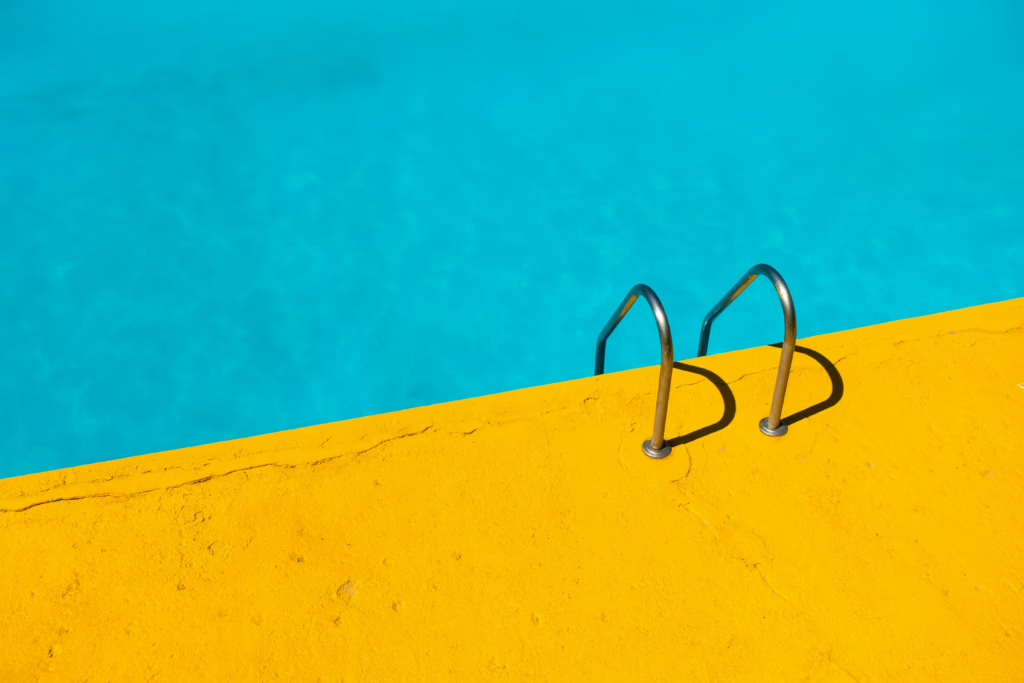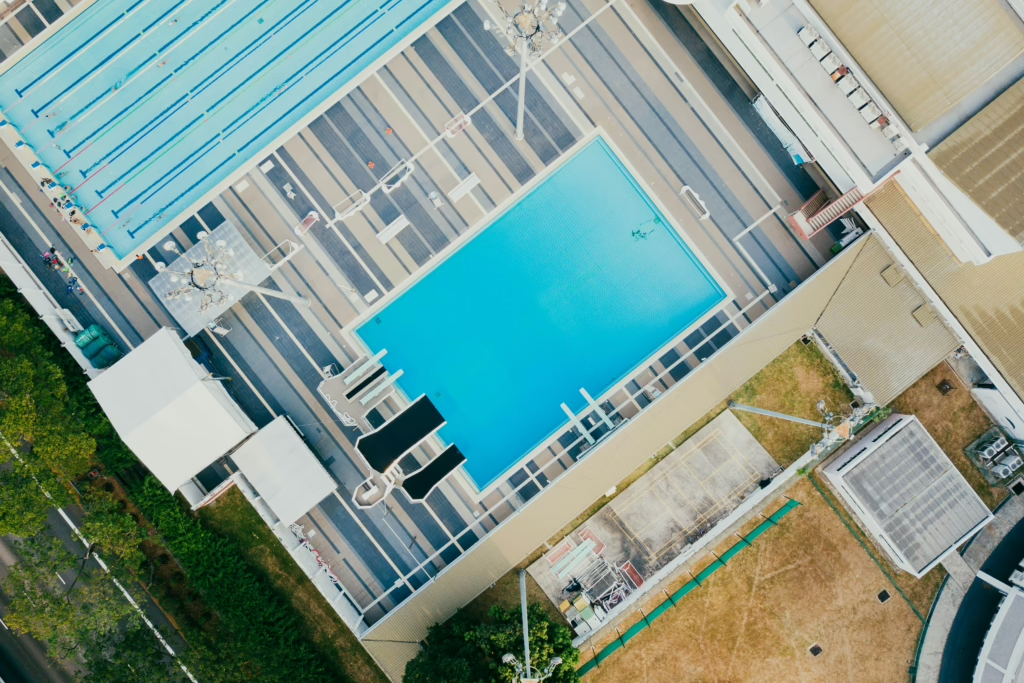Let’s be honest – there’s nothing worse than taking that excited leap into your pool on a scorching San Diego day, only to find murky water and mysterious floating bits. Been there, done that! As fellow pool owners in America’s Finest City, we’ve all asked ourselves, “So how often do I really need to clean this thing?” While the textbook answer is once a week, real life in Southern California throws us some curveballs. Our beautiful sunshine that makes pool days possible year-round? It’s also creating the perfect breeding ground for algae and evaporating water faster than you can say “cannonball!”
If you’ve found yourself frantically typing “pool cleaning near me” into your phone while staring at a green-tinged pool before guests arrive (we’ve all been there!), you know finding someone reliable who actually shows up when promised feels like striking gold. Most of us are caught in that frustrating balance of wanting to enjoy our pools without becoming part-time chemists and maintenance technicians. That’s exactly why I decided to put together this straight-talking guide about pool cleaning frequency and finding help that won’t break the bank.
I’m going to walk you through the real factors that determine your pool’s cleaning needs – not just the idealized schedule that assumes you don’t have kids throwing popsicles in the deep end or palm trees dropping fronds during every slight breeze. We’ll talk about what professional services actually include (versus what they claim to include), and some sanity-saving tips for maintenance between visits. Whether you’re a new pool owner still in the honeymoon phase or a veteran who’s seen it all, these practical insights will help keep your pool swim-ready without consuming your weekends.
Why Regular Pool Cleaning Is Essential
Let’s get real – in San Diego, our pools aren’t just summer splurge items gathering dust for 9 months of the year. We’re jumping in during October heat waves and even those random warm February days! This year-round usage means your pool doesn’t get much downtime to recover from all those sunscreen-covered bodies and neighborhood leaves. Without regular attention, that sparkling blue oasis can quickly transform into something that looks like it belongs in a swamp documentary.
I learned this lesson the hard way after skipping maintenance for just three weeks while on vacation. What awaited me wasn’t just ugly green water – it was a $600 repair bill because the pump had been struggling with clogged baskets. Ouch! Regular cleaning isn’t just about keeping things pretty; it’s about not having that sinking feeling when your pool guy says, “Well, there’s your problem…” while pointing at an expensive piece of equipment. Trust me, establishing a cleaning routine is way less painful than explaining to your spouse why the vacation fund is now the “fix the pool” fund.
Factors That Influence Pool Cleaning Frequency
1. Climate and Weather Conditions
Sure, we San Diegans love bragging about our “perfect” weather to out-of-town relatives, but let’s be honest about the pool maintenance challenges our climate throws at us:
- Those gorgeous 80° days in January? They’re basically sending algae an engraved invitation to your pool party
- Living near the beach sounds dreamy until you’re fishing out sand that mysteriously appears even when nobody’s been to the shore
- Santa Ana winds don’t just mess up your hair – they dump half your neighbor’s yard into your water within hours
- Those rare rainy days we pray for? They come with the bonus gift of messing up your carefully balanced chemicals
- The shift from May Gray to scorching August can send your pool chemistry into a tailspin faster than you can say “pH tester”
I’ve learned to check the weather forecast not just for planning beach days, but for knowing when my pool’s going to need emergency attention. After a Santa Ana event last year, I found palm fronds, someone’s baseball cap (not mine!), and what I’m pretty sure was part of a take-out menu floating in my formerly pristine water.
2. Pool Usage Patterns
How you use your pool significantly impacts its cleaning needs:
- High-traffic pools with frequent swimmers require more frequent cleaning
- Family pools with children often need additional attention due to sunscreen, oils, and other contaminants
- Pools used for entertaining or parties may need cleaning after each major event
- Vacation homes with intermittent use have different maintenance requirements
- Therapy or exercise pools with daily use need consistent care
Being honest about your pool’s usage patterns helps determine the right cleaning frequency for your specific situation.
3. Surrounding Environment
Your pool doesn’t exist in isolation—its surroundings play a major role in its cleanliness:
- Pools near trees or gardens collect more organic debris like leaves and pollen
- Properties in dusty areas or near construction sites face more particulate contamination
- Coastal homes may deal with salt air that affects water chemistry
- Pools with landscape lighting or features nearby may attract more insects
- Yards with pets introduce additional considerations for pool maintenance
Evaluating your pool’s environment helps you anticipate potential issues and adjust your cleaning schedule accordingly.
4. Pool Type and Features
Different pool types and features have unique maintenance requirements:
- Saltwater pools require less chemical maintenance but still need regular cleaning
- Pools with water features like fountains or waterfalls need additional attention
- Infinity pools have special edge systems that require maintenance
- Pools with attached spas have more equipment to maintain
- Pools with specialized finishes may need specific cleaning products and techniques
Understanding your pool’s specific features helps you create a tailored maintenance plan rather than following a one-size-fits-all approach.
Recommended Pool Cleaning Schedule for San Diego
Based on San Diego’s climate and typical pool usage patterns, here’s a recommended maintenance schedule:
Weekly Tasks:
- Skim the surface to remove floating debris
- Empty skimmer and pump baskets
- Brush walls, steps, and ladders to prevent algae buildup
- Test and adjust chemical levels (pH, chlorine, alkalinity)
- Check water level and top off if needed
Bi-Weekly Tasks:
- Vacuum the pool floor thoroughly
- Clean the waterline to remove oils and buildup
- Inspect equipment for proper function
- Backwash or clean filters as needed
Monthly Tasks:
- Conduct a comprehensive water test (including calcium hardness, cyanuric acid, etc.)
- Deep clean any water features
- Check for leaks in the system
- Inspect pool surfaces for damage or wear
Seasonal Tasks:
- Spring: Prepare for increased usage with a thorough cleaning and equipment check
- Summer: Maintain vigilance during peak usage months
- Fall: Adjust chemical levels for decreased usage
- Winter: Prepare for rain and maintain even during lower usage periods
For many San Diego homeowners, this maintenance schedule is difficult to maintain consistently, which is why professional pool services become an attractive option.
When Your Pool Needs Immediate Attention
Sometimes your pool needs cleaning outside of your regular schedule. Watch for these warning signs:
1. Water Clarity Issues
If you can’t clearly see the bottom of your pool, it’s time for immediate action. Cloudy water indicates potential chemical imbalances or filtration problems that should be addressed promptly.
2. Visible Algae Growth
Green, black, or yellow spots on pool surfaces are signs of algae growth. Once algae takes hold, it can spread rapidly and become much more difficult to eliminate.
3. Unusual Odors
A strong chlorine smell doesn’t mean your pool has too much chlorine—ironically, it often indicates not enough free chlorine. This smell comes from chloramines, which form when chlorine combines with contaminants.
4. Equipment Issues
Unusual noises from your pump, pressure changes in your filter, or inconsistent water circulation are all signs that something isn’t right with your pool system.
5. After Major Events
Heavy rain, dust storms, pool parties, or extended periods of high heat may all necessitate additional cleaning beyond your regular schedule.
Benefits of Professional Pool Cleaning Services
While some homeowners choose to handle pool maintenance themselves, there are significant advantages to hiring professionals:
1. Expertise and Experience
Professional pool technicians understand water chemistry, equipment function, and maintenance best practices. Their trained eyes can spot potential issues before they become problems.
2. Time Savings
Pool maintenance is time-consuming when done properly. Professional services free up your time to actually enjoy your pool rather than constantly maintaining it.
3. Equipment and Resources
Professionals bring commercial-grade testing equipment, cleaning tools, and products that may be more effective than consumer-grade alternatives.
4. Consistent Results
Regular service schedules ensure your pool never falls into disrepair, maintaining consistent water quality and equipment function.
5. Cost-Effective in the Long Run
Regular professional maintenance can prevent expensive repairs and extend the life of your pool and equipment, potentially saving money over time.
Frequently Asked Questions:
1. How much does professional pool cleaning cost in San Diego?
Let’s talk money – professional pool cleaning in San Diego typically runs between $80-$150 monthly. Is that cheap? Not exactly. But here’s what my neighbor Tom (who’s on his third pool pump in five years) would tell you: paying for regular maintenance beats emergency repairs every time. Plus, what’s the value of your Saturday mornings back? For me, it’s priceless.
2. What exactly does a professional pool cleaning service include?
When you’re paying good money, you want to know what you’re getting, right? A decent service should handle all the basics: skimming off those floating mysteries, vacuuming up the stuff that sank, brushing walls before algae gets comfortable, emptying those gross hair-filled baskets, balancing your chemicals, and making sure your equipment isn’t making death rattles. Better services will clean filters, scrub tiles, and actually check if your equipment is about to give up the ghost.
3. How long does a typical pool cleaning service take?
Most pros will be in and out in 30-60 minutes. My guy Mike typically takes about 45 minutes for my average-sized pool. The first visit might take longer because they’re basically conducting a CSI investigation on your water and equipment. If someone’s done in 10 minutes, they’re either a miracle worker or they’re cutting serious corners!
4. Do I need to be home during pool cleaning service?
Most services can be performed without the homeowner present, as long as the technician has access to your pool area. Many clients prefer to schedule regular service when they’re away to avoid disruptions.
5. Can I switch between DIY and professional cleaning?
Absolutely! Some homeowners handle basic maintenance themselves and schedule professional services monthly for deeper cleaning. Others rely on professionals weekly and only perform minor maintenance between visits.
6. What should I do between professional cleanings?
Simple tasks like skimming the surface, checking water levels, and ensuring your pump is running properly can maintain your pool between professional visits. Your service provider can recommend specific tasks based on your pool’s needs.
7. Are there different service levels available?
Most companies offer tiered service plans ranging from basic (chemical balancing and skimming) to comprehensive (including equipment maintenance and repairs). Discussing your specific needs with potential providers will help you choose the right level of service.
8. How do I choose the best pool cleaning service?
Look for companies with strong reviews, proper licensing and insurance, transparent pricing, and good communication. A quality provider should be willing to explain their process and answer all your questions.
9. What chemicals are used in professional pool cleaning?
Professionals typically use chlorine or bromine for sanitizing, pH adjusters, alkalinity increasers, calcium hardness adjusters, and algaecides. Many companies now offer salt-based systems and other alternatives for those seeking different options.
10. How quickly can I expect to see results from professional pool cleaning?
Most pools show immediate improvement after a thorough professional cleaning. However, pools with significant issues may require multiple visits to achieve optimal results.
Final Thoughts
Look, keeping your pool swim-ready in San Diego isn’t rocket science, but it does require some consistency and know-how. While the whole “clean it weekly” advice is a good starting point, your specific situation might need a different approach. Maybe your massive oak tree or your teenager’s daily pool parties with half the high school swim team are game-changers. The key is paying attention to your pool’s unique personality (and yes, after a while, you’ll swear your pool has one!).
If you’re like me and have finally accepted that Google searches for “pool cleaning near me” are becoming a regular part of your browser history, give us a call at PoolLogic. We’ve stripped away all the complicated stuff and created a 5-minute setup process that won’t have you tearing your hair out. No 20-page contracts or confusing pricing tiers – just tell us about your pool, your schedule, and what’s driving you crazy, and we’ll handle the rest.
Ready to stop being a weekend pool warrior and actually enjoy swimming instead of skimming? Life’s too short to spend it chasing pH balance and scrubbing waterlines. Your perfect San Diego pool day is waiting – and it doesn’t include you wielding a pool vacuum! Give us a call, and let’s get you back to what pools are actually for: cannonballs, floating with a drink in hand, and making memories.



